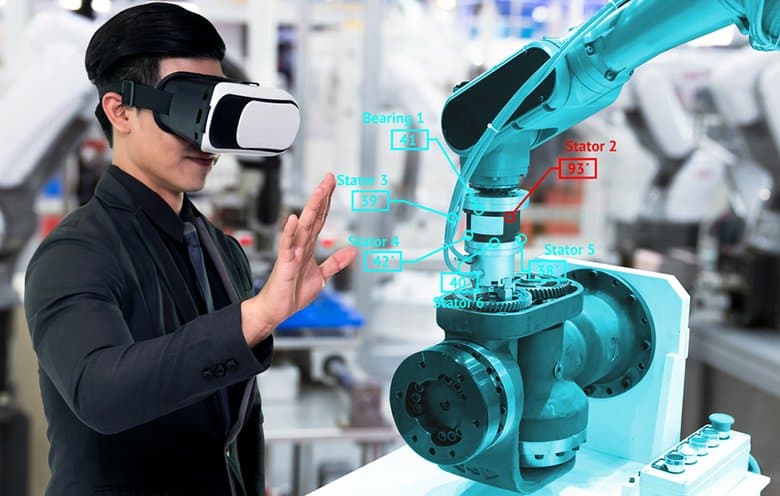The technology known as Virtual Reality underwent rapid developmental changes from being an exclusive entertainment product to become a disruptive technology across various industries. Just in 2023 the immersive virtual reality market size reached $15.7 billion based on Grand View Research and is expected to experience a CAGR of 26.6% from 2024 to 2030. Innovative awareness of immersive VR drives new expansion for its medical and educational applications and real estate innovations and company-wide partnerships.

VR adoption is driving forward particular industries which use this technology for achieving remarkable growth potential. India and the United States observe tremendous VR adoption through the analysis of their major five business sectors.
1. Education and Training
The education sector has started a VR-powered transformation across the territory of both India and the United States. Education now uses interactive virtual environments to let students explore historical moments and space-based venues and conduct challenging medical procedures.
The Indian startup Veative Labs implements VR educational modules within educational institutions to make STEM instruction more effective. The Digital India campaign drives government support which accelerates public and private educational institutions to adopt virtual reality technology.
Stanford along with Harvard among other American educational institutions implement virtual reality systems for medical training and engaging classroom instruction. The University of Maryland conducted research indicating students remember better information through their VR tools instead of conventional studied materials.
Organization training uses virtual reality to develop new employees and deliver mandatory materials and interpersonal skills lessons. Walmart trains its staff through virtual reality for Black Friday situations which enables better preparation and lessens in-store confusion.
Virtual reality applications in education boost student retention along with engagement through vivid educational activities that enable users to engage with abstract ideas directly thus benefiting engineering and healthcare students. Virtual reality serves as an effective solution to close the engagement gap between video-based learning by offering remote education solutions through hybrid and distance learning models.
2. Healthcare and Medical Simulation
The healthcare field has received a revolution from virtual reality through its creation of risk-free training systems along with therapy solutions. Through virtual patients surgeons get opportunities for procedure practice while therapists employ VR to help patients with PTSD and phobias.
Indian healthcare institutions collaborate with businesses to establish VR-based educational programs for both hospital nurses and emergency medical personnel. Two healthcare institutions including AIIMS and Apollo Hospitals are now using virtual reality technology to instruct residents and interns about risky procedures.

The US medical sector utilizes Osso VR to supply simulated surgery spaces which enhances both skill proficiency and precision during medical procedures. The virtual rehabilitation system of VRHealth offers healthcare tools and therapeutic environments that assist patients following medical trauma and surgery.
Healthcare professionals use VR to offer telemedical consultations through virtual spaces and this technology proves essential for areas that lack sufficient healthcare centers. The combination of wearable sensors and virtual reality applications leads to their utilization in robotic surgery practice and therapy plus posture correction methods.
The immersive qualities of VR enable physicians to assist patients with chronic pain management as well as anxiety by offering distraction treatment that demonstrates strong potential in mental healthcare. Anxiety disorder patients use virtual reality technology as part of exposure therapy because it creates a protected space to slowly confront their phobias.
3. Real Estate and Architecture
The method of property evaluation has changed because customers no longer depend solely on photographs and blueprints. VR technologies enable clients to navigate through materials from properties and architectural plans thus enhancing both decision-making quality and process speed.
The usage of VR technology by Indian firms provides remote property tours particularly to Non-Resident Indians (NRIs). Modern builders include virtual reality in their promotional practices to enable customers to design their spaces and see simulated daytime conditions and preview available facilities.
Through Matterport users can view three-dimensional home models using virtual reality headsets on the United States market. The real estate platforms Zillow and Redfin dedicate investments to develop virtual reality content that makes their products more engaging and minimizes confusion among potential buyers.
The real-time collaboration feature of Virtual Reality allows architects to work with their clients alongside team members all over the world. Stakeholders can immediately view design progress and give feedback through VR integration that Autodesk Revit provides.
The interactive preview provides better customer satisfaction and cuts down the length of the sales process. The use of virtual reality by developers enables construction employee training for challenging structures which produces better protection in building sites and superior project results.
4. Retail and E-Commerce
High online shopping activity drives retailers to use virtual reality for building enhanced personalized shopping interactions.
The Indian brands Tata CliQ and Lenskart use virtual reality to provide virtual try-ons alongside virtual stores exploratory experiences to their customers. Customers of Myntra can now use virtual reality technology to view product collections similar to a genuine shopping mall experience.
The USA’s biggest retailers Walmart along with Macy’s are exploring the use of virtual reality to develop trial services for products as well as virtual shopping spaces. Online platform Shopify launched VR integration which enables small merchandise brands to display their products in three-dimension format.

VR technology extends its impact to grocery shopping alongside furniture selection and it allows customers to try beauty products virtually. Customers benefit from two virtual experiences involving both makeup trials without actual products and home furniture preview capabilities.
Virtual reality creates a combination of physical and digital shopping that decreases product returns together with higher customer trust levels. Businesses utilize the system to obtain behavioral information that enables them to create personalized marketing offers to strengthen customer commitment.
5. Entertainment and Events
The entertainment field became the initial standard use of virtual reality which endures to develop and transform. Virtual Reality offers more than gaming experiences because it now enables users to attend virtual concerts while also observing film festivals and watching live sports matches.
The Indian film sector develops VR technology to build immersive narratives and strengthen relationships with viewers. Bollywood film directors explore 360-degree films to present totally new viewing perspectives to audiences.
NextVR operates from the US to provide virtual live sports and concert experiences alongside other American VR companies at the forefront. The company “Meta” puts significant capital into the development of Horizon Worlds which enables users to attend events and organized meetups through a vast virtual reality realm.
TwinReality revolutionizes event hosting through their platform which enables users to build personalized virtual event spaces for launch events and exhibitions and multiple other types of events. Their advanced capabilities to build immersive VR products and scalable systems enables them to dominate this particular market sector.
The combination of physical movement and digital immersion through VR technology has become destructive to theme parks and arcades as new interactive experiences emerge. Most esports tournaments now employ VR-based gaming which enhances both participant engagement and spectator participation levels.
Conclusion
Virtual reality moves out of science fiction status to become an essential innovation tool that increases operational efficiency in education and entertainment sectors. Startups and established businesses inside India alongside the US contribute massive financial investments to immerse technology development.
Businesses that introduce VR solutions at the beginning of the industry transformation era will obtain better customer interactions as well as better operational flow and market dominance. TwinReality solutions offer an opportunity for businesses to understand virtual reality applications because the upcoming world will be extensive beyond digital to include immersive experiences.


